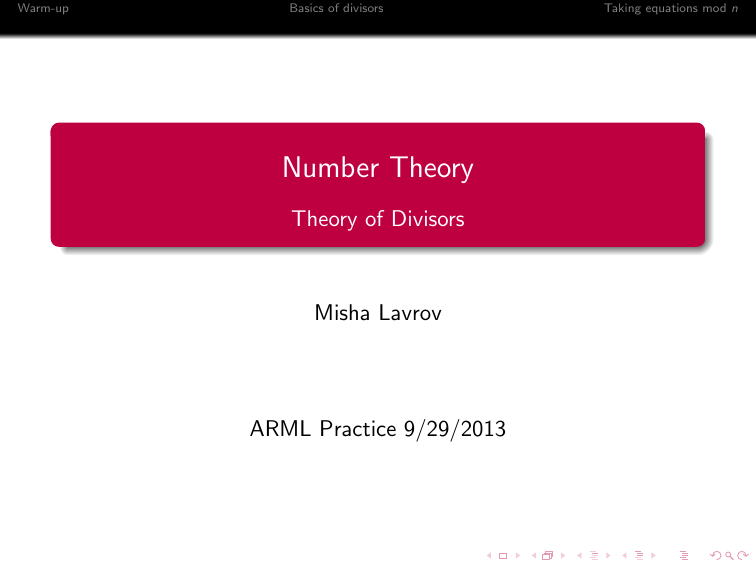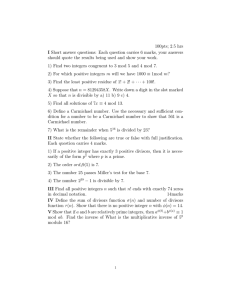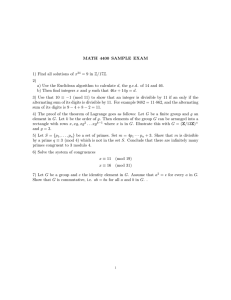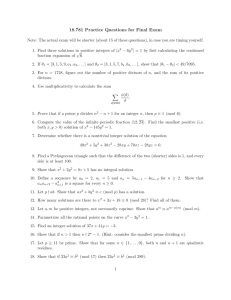Number Theory - Theory of Divisors
advertisement

Warm-up Basics of divisors Number Theory Theory of Divisors Misha Lavrov ARML Practice 9/29/2013 Taking equations mod n Warm-up Basics of divisors Taking equations mod n Warm-up HMMT 2008/2. Find the smallest positive integer n such that 107n has the same last two digits as n. IMO 2002/4. Let n be an integer greater than 1. The positive divisors of n are d1 , d2 , . . . , dk , where 1 = d1 < d2 < · · · < dk = n. Define D = d1 d2 + d2 d3 + · · · + dk−1 dk . (a) Prove that D < n2 . (b) Determine all n for which D is a divisor of n2 . Warm-up Basics of divisors Taking equations mod n Warm-up Solutions 1 Two numbers have the same last two digits just when they are the same mod 100, and n ≡ 107n (mod 100) ⇔ n ≡ 7n (mod 100) ⇔ 6n ≡ 0 (mod 100) ⇔ 6n = 100k for some k k ⇔ n = 50 · . 3 So n must be a multiple of 50, and the smallest such positive number is 50 itself. 2 The IMO problem is left as an exercise. Warm-up Basics of divisors Taking equations mod n Divisors of 10000 We can arrange the divisors of 10000 in a square grid: 1 5 25 125 625 2 10 50 250 1250 4 20 100 500 2500 8 40 200 1000 5000 16 80 40 2000 10000 Warm-up Basics of divisors Taking equations mod n Divisors of 10000 We can arrange the divisors of 10000 in a square grid: 1 5 25 125 625 2 10 50 250 1250 4 20 100 500 2500 8 40 200 1000 5000 16 80 40 2000 10000 Questions: How many divisors of 10000 are divisors of 200? What is the sum of all the divisors of 10000? (Try to figure out how to avoid using brute force.) How many divisors does 10100 have? How many divisors does 3600 have? Warm-up Basics of divisors Taking equations mod n Competition-level questions AIME 1998/5. If a random divisor of 1099 is chosen, what is the probability that it is a multiple of 1088 ? PUMaC 2011/NT A1. The only prime factors of an integer n are 2 and 3. If the sum of the divisors of n (including n itself) is 1815, find n. Original. How many divisors x of 10100 have the property that the number of divisors of x is also a divisor of 10100 ? Warm-up Basics of divisors Taking equations mod n Competition-level questions Solutions AIME 1998/5. The divisors of 1099 form a 100 × 100 grid. In the grid, the multiples of 1088 are the numbers below and to the right of 1088 , which form a 12 × 12 grid. So the probability is 12 · 12 = 0.0144. 100 · 100 Warm-up Basics of divisors Taking equations mod n Competition-level questions Solutions AIME 1998/5. The divisors of 1099 form a 100 × 100 grid. In the grid, the multiples of 1088 are the numbers below and to the right of 1088 , which form a 12 × 12 grid. So the probability is 12 · 12 = 0.0144. 100 · 100 PUMaC 2011/NT A1. First note that 1815 factors as 3 · 5 · 112 . If n = 2a · 3b , the sum of its divisors is (1 + 2 + 4 + · · · + 2a )(1 + 3 + 9 + · · · + 3b ). The sums of powers of 2 begin 1, 3, 7, 15, 31, . . . and the sums of powers of 3 begin 1, 4, 13, 40, 121, . . . . At this point we spot that 15 · 121 = 1815. This is 1 + 2 + 4 + 8 times 1 + 3 + 9 + 27 + 81, so n is 8 · 81 = 648. Warm-up Basics of divisors Taking equations mod n Competition-level questions Solutions Original. Since 10100 = 2100 · 5100 , x must also be of the form 2a · 5b , where 0 ≤ a ≤ 100 and 0 ≤ b ≤ 100. The divisors of x form their own grid, with a + 1 columns (there are a + 1 choices for the power of 2, namely 20 , 21 , 22 , . . . , 2a ) and b + 1 rows (there are b + 1 choices for the power of 5). The total number of divisors of x is (a + 1)(b + 1). If this number is also a divisor of 10100 , then both a + 1 and b + 1 must be products of 2’s and 5’s. There are no further restrictions on x. So a + 1 and b + 1 can each be one of: 1, 2, 4, 8, 16, 32, 64, 5, 10, 20, 40, 80, 25, 50, 100. There are 15 possibilities for a and for b, so there are 152 = 225 possibilities for x. Warm-up Basics of divisors Taking equations mod n Taking equations mod n Pythagorean triples Problem If x, y , z are integers and x 2 + y 2 = z 2 , show that 60 divides xyz. Warm-up Basics of divisors Taking equations mod n Taking equations mod n Pythagorean triples Problem If x, y , z are integers and x 2 + y 2 = z 2 , show that 60 divides xyz. All three of x, y , z cannot be odd, since odd + odd = even. So xyz is even. Warm-up Basics of divisors Taking equations mod n Taking equations mod n Pythagorean triples Problem If x, y , z are integers and x 2 + y 2 = z 2 , show that 60 divides xyz. All three of x, y , z cannot be odd, since odd + odd = even. So xyz is even. Since 12 ≡ 22 ≡ 1 (mod 3), all perfect squares are 0 or 1 mod 3. But x 2 + y 2 ≡ z 2 (mod 3) is not solved by making each of x 2 , y 2 , and z 2 be 1 mod 3. So one is 0 mod 3, and so xyz is divisible by 3. Warm-up Basics of divisors Taking equations mod n Taking equations mod n Pythagorean triples Problem If x, y , z are integers and x 2 + y 2 = z 2 , show that 60 divides xyz. All three of x, y , z cannot be odd, since odd + odd = even. So xyz is even. Since 12 ≡ 22 ≡ 1 (mod 3), all perfect squares are 0 or 1 mod 3. But x 2 + y 2 ≡ z 2 (mod 3) is not solved by making each of x 2 , y 2 , and z 2 be 1 mod 3. So one is 0 mod 3, and so xyz is divisible by 3. Mod 5, we have 12 ≡ 42 ≡ 1 and 22 ≡ 32 ≡ −1. So x 2 + y 2 ≡ z 2 (mod 5) can look like 0 ± 1 ≡ ±1 or 1 − 1 ≡ 0. So one of x, y , or z is 0 mod 5, and xyz is divisible by 5. Warm-up Basics of divisors Taking equations mod n Taking equations mod n Pythagorean triples Problem If x, y , z are integers and x 2 + y 2 = z 2 , show that 60 divides xyz. All three of x, y , z cannot be odd, since odd + odd = even. So xyz is even. Since 12 ≡ 22 ≡ 1 (mod 3), all perfect squares are 0 or 1 mod 3. But x 2 + y 2 ≡ z 2 (mod 3) is not solved by making each of x 2 , y 2 , and z 2 be 1 mod 3. So one is 0 mod 3, and so xyz is divisible by 3. Mod 5, we have 12 ≡ 42 ≡ 1 and 22 ≡ 32 ≡ −1. So x 2 + y 2 ≡ z 2 (mod 5) can look like 0 ± 1 ≡ ±1 or 1 − 1 ≡ 0. So one of x, y , or z is 0 mod 5, and xyz is divisible by 5. These mean xyz is divisible by 30. Getting 60 is left as an exercise (Hint: try mod 8.) Warm-up Basics of divisors Taking equations mod n Taking equations mod n Competition-level problems Original. If x, y , z are integers and x 2 + y 2 = 3z 2 , show that x = y = z = 0. PUMaC 2007/NT B2. How many positive integers n are there such that n + 2 divides (n + 18)2 ? British MO 2005/6. Let n be an integer greater than 6. Prove that if n − 1 and n + 1 are both prime, then n2 (n2 + 16) is divisible by 720. PUMaC 2009/NT A3. Find all prime numbers p which can be written as p = a4 + b 4 + c 4 − 3 for some primes (not necessarily distinct) a, b, and c. Warm-up Basics of divisors Taking equations mod n Taking equations mod n Competition-level problems Original. If x, y , z are integers and x 2 + y 2 = 3z 2 , show that x = y = z = 0. (Hint: mod 3) PUMaC 2007/NT B2. How many positive integers n are there such that n + 2 divides (n + 18)2 ? (Hint: mod n + 2) British MO 2005/6. Let n be an integer greater than 6. Prove that if n − 1 and n + 1 are both prime, then n2 (n2 + 16) is divisible by 720. (Hint: mod 2, 3, and 5) PUMaC 2009/NT A3. Find all prime numbers p which can be written as p = a4 + b 4 + c 4 − 3 for some primes (not necessarily distinct) a, b, and c. (Hint: mod 2, 3, and 5) Warm-up Basics of divisors Taking equations mod n Taking equations mod n Solutions Original. If x 2 + y 2 = 3z 2 , then x 2 + y 2 ≡ 0 (mod 3), which is only possible if x ≡ y ≡ 0 (mod 3). So both x and y are divisible by 3, so x 2 + y 2 is divisible by 9, and therefore z 2 is divisible by 3. We now have (x/3)2 + (y /3)2 = 3(z/3)2 , so the same is true of x/3, y /3, z/3. But the numbers cannot have infinitely many factors of 3 unless they are all 0. Warm-up Basics of divisors Taking equations mod n Taking equations mod n Solutions Original. If x 2 + y 2 = 3z 2 , then x 2 + y 2 ≡ 0 (mod 3), which is only possible if x ≡ y ≡ 0 (mod 3). So both x and y are divisible by 3, so x 2 + y 2 is divisible by 9, and therefore z 2 is divisible by 3. We now have (x/3)2 + (y /3)2 = 3(z/3)2 , so the same is true of x/3, y /3, z/3. But the numbers cannot have infinitely many factors of 3 unless they are all 0. PUMaC 2007/NT B2. Since n + 18 ≡ 16 (mod n + 2), (n + 18)2 ≡ 162 (mod n + 2) We are given (n + 18)2 ≡ 0 (mod n + 2), so 162 ≡ 0 (mod n + 2), which means n + 2 divides 256. Therefore n + 2 is one of 22 , 23 , . . . , 28 , which gives 7 solutions. Warm-up Basics of divisors Taking equations mod n Taking equations mod n Solutions BMO 2005/6. Divisibility by 144 is easy. Neither n + 1 nor n − 1 is even, so n must be even; and neither n + 1 nor n − 1 is divisible by 3, so n must be divisible by 3. Therefore n = 6k, and n2 (n2 + 16) = (6k)2 ((6k)2 + 16) = 144 · k 2 (9k 2 + 4). Now all we need is divisibility by 5. Since neither n + 1 nor n − 1 is divisible by 5, we have one of n ≡ 0, 2, 3 (mod 5). Fortunately, 2 2 (mod 5) 0 (0 + 16) = 0 ≡ 0 2 2 2 (2 + 16) = 80 ≡ 0 (mod 5) 2 2 3 (3 + 16) = 225 ≡ 0 (mod 5). So in all three cases, n2 (n2 + 16) is divisible by 5. Warm-up Basics of divisors Taking equations mod n Taking equations mod n Solutions PUMaC 2009/NT A3. The primes 2, 3, and 5 have the following property: if p is one of 2, 3, or 5, then either a ≡ 0 (mod p) or a4 ≡ 1 (mod p). This is easy to check: 4 (mod 2) 1 ≡ 1 4 4 1 ≡2 ≡1 (mod 3) 4 4 4 4 1 ≡2 ≡3 ≡4 ≡1 (mod 5). Suppose none of a, b, or c are 2. They are prime, so not divisible by 2. But then p = a4 + b 4 + c 4 − 3 ≡ 1 + 1 + 1 − 3 ≡ 0 (mod 2) and p is divisible by 2 (but it’s easy to check p = 2 doesn’t work). So one of a, b, or c has to be 2. The same argument shows that one of a, b, or c has to be 3, and one has to be 5. This means p = 24 + 34 + 54 − 3 = 719.








